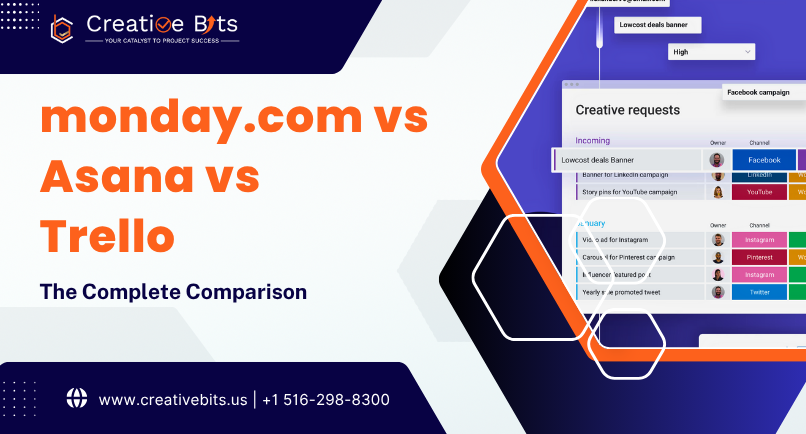Table of Contents
- Introduction: Why Monday.com vs Asana vs Trello Matters
- monday.com: The Visual Work OS
- Asana: The Structured Task Master
- Trello: The Kanban Simplicity Champion
- Feature-by-Feature Comparison
- Pricing Breakdown
- Which Tool is Right for Your E-commerce Business?
- Conclusion
Introduction: Why monday.com vs Asana vs Trello Matters {#introduction}
monday.com vs Asana vs Trello - choosing the right project management tool can transform your e-commerce operations from chaotic to streamlined. In the rapidly expanding e-commerce industry, teams rely on these powerful project management tools to organize their work, handle marketing campaigns, and ensure products are released on time.
But with so many platforms to choose from, it can be tough for businesses to decide which one fits their needs best. According to Gartner's 2023 research, almost 80% of organizations now use project and work management software to handle workflows in distributed or remote teams.
For companies like Creative Bits, choosing between monday.com vs Asana vs Trello goes beyond just managing tasks—it also involves ensuring the system can:
- Scale with business growth
- Support cross-department teamwork
- Keep clients informed efficiently
- Integrate with existing e-commerce platforms
This comprehensive comparison of monday.com vs Asana vs Trello breaks down their pros and cons, helping you make the best choice for your e-commerce company.
monday.com: The Visual Work OS {#monday.com}
What Makes monday.com Stand Out
monday.com is a Work Operating System (Work OS), which lets teams create workflows using visual boards they can customize. When comparing monday.com vs Asana vs Trello for e-commerce companies, monday.com's visual approach is especially helpful for:
- Managing product listings
- Coordinating marketing efforts
- Tracking supply chain updates
- Automating repetitive tasks
The platform's automation tools significantly reduce time spent on repetitive jobs like sending reminders, getting approvals, and sending notifications.
Key monday.com Features for E-commerce
Visual Dashboards: One major advantage in the monday.com vs Asana vs Trello comparison is monday.com's flexible dashboards. Teams can consolidate:
- Sales data
- Shipping updates
- Customer support information
All in a single location, providing complete visibility across different business departments.
E-commerce Integrations: monday.com connects seamlessly with:
This makes it extremely valuable for managing online stores compared to other options.
monday.com Limitations
Some users report that monday.com:
- Costs more than Trello
- Has a steeper learning curve for beginners
- Requires dedicated onboarding time
Asana: The Structured Task Master {#asana}
Why Choose Asana
Asana has earned its reputation through a structured approach to handling tasks and projects. In the monday.com vs Asana vs Trello debate, Asana excels at:
- Breaking large projects into manageable tasks and subtasks
- Creating task dependencies
- Planning complex campaigns
For e-commerce marketing teams comparing monday.com vs Asana vs Trello, Asana particularly shines in organizing:
- SEO content creation strategies
- Paid advertising tracking
- Influencer campaign management
- Product launch timelines
Advanced Asana Features
Timeline and Workload Management: These features help managers:
- Balance team workloads effectively
- Reduce project delays
- Visualize project dependencies
- Track progress in real-time
Extensive Integrations: Asana connects with 200+ apps, including:
However, it lacks the direct e-commerce integrations that monday.com provides.
Asana Drawbacks
When evaluating monday.com vs Asana vs Trello, consider that Asana's:
- Advanced features (timelines, workload management, reporting) require premium plans
- Pricing can be prohibitive for small e-commerce startups
- Learning curve is moderate for new users
Trello: The Kanban Simplicity Champion {#trello}
Trello's Appeal
Trello's easy-to-use Kanban board system makes it a favorite among startups and small teams. In the monday.com vs Asana vs Trello comparison, Trello wins for simplicity.
Users can create:
- Boards for different projects
- Lists for workflow stages
- Cards for individual tasks
For e-commerce teams, Trello effectively handles:
- Order tracking
- Content calendar management
- Customer support request processing
Power-Ups and Extensions
Trello's Power-Ups system allows connections with:
This flexibility helps small teams customize their workflow without complexity.
Trello Limitations
When considering monday.com vs Asana vs Trello for scaling businesses, Trello shows weaknesses in:
- Handling complex workflows
- Managing large teams
- Providing robust reporting
- Offering advanced automation
Feature-by-Feature Comparison {#comparison}
1. User Interface and Ease of Use
monday.com vs Asana vs Trello interface comparison:
- monday.com: Visually appealing with color-coded boards; requires onboarding
- Asana: Structured list and timeline views; suits organized teams
- Trello: Simplest Kanban layout; quickest adoption rate
2. Collaboration and Communication
How monday.com vs Asana vs Trello handle team collaboration:
- monday.com: Built-in chat, file sharing, cross-board updates
- Asana: Comments, @mentions, Slack integration
- Trello: Card-based discussions, relies on integrations for advanced communication
3. Integration Capabilities
monday.com vs Asana vs Trello integration comparison:
| Platform | Number of Integrations | E-commerce Focus |
|---|---|---|
| monday.com | 200+ | Strong (Shopify, WooCommerce) |
| Asana | 200+ | Limited |
| Trello | 100+ (Power-Ups) | Moderate |
4. Automation Features
Comparing automation in monday.com vs Asana vs Trello:
- monday.com: Advanced automation recipes for approvals, reminders, workflows
- Asana: Rule-based automations for task assignment, status updates
- Trello: Butler automation (basic but functional)
5. Reporting and Analytics
monday.com vs Asana vs Trello analytics capabilities:
- monday.com: Customizable dashboards with real-time insights
- Asana: Task, deadline, and workload reports (premium features)
- Trello: Limited native reporting; requires Power-Ups
Pricing Breakdown {#pricing}
Monday.com vs Asana vs Trello Pricing Comparison:
| Tool | Free Plan | Starting Price | Best For |
|---|---|---|---|
| monday.com | Yes, for only 14 days | $9/user/month | Growing e-commerce teams |
| Asana | Yes (15 users) | $10.99/user/month | Structured project management |
| Trello | Yes | $5/user/month | Small teams, startups |
Prices as of 2025. Check official websites for current pricing.
Which Tool is Right for Your E-commerce Business? {#recommendation}
Choose monday.com if:
- You need strong e-commerce platform integrations
- Automation is a priority
- Visual workflows appeal to your team
- Budget allows for premium features
Choose Asana if:
- You prefer structured task management
- Campaign planning is crucial
- Team workload balancing is important
- You need detailed project timelines
Choose Trello if:
- Simplicity is paramount
- Budget is limited
- Team is small (under 10 people)
- Basic project tracking suffices
Creative Bits Expert Recommendation
After extensive analysis of monday.com vs Asana vs Trello, we recommend:
For complex e-commerce operations, monday.com emerges as the winner. Its robust automation, live dashboards, and seamless Shopify integration make it invaluable for retail operations management.
For marketing-focused teams, Asana provides the structure needed for campaign management and content planning.
For startups, Trello offers the perfect balance of functionality and affordability.
Learn more about our project management consulting services
Conclusion: Making the Right Choice in monday.com vs Asana vs Trello {#conclusion}
The monday.com vs Asana vs Trello decision ultimately depends on:
- Business size and growth trajectory
- Task complexity
- Budget constraints
- Integration requirements
- Team technical proficiency
monday.com stands out for businesses needing powerful e-commerce tools and automation. Asana excels for teams requiring structured project planning. Trello wins when simplicity and cost-effectiveness are priorities.
For e-commerce teams aiming for long-term growth and enhanced cross-department collaboration, monday.com emerges as the superior platform in the monday.com vs Asana vs Trello comparison. However, the right tool is the one that aligns with your specific business needs and helps you deliver exceptional customer experiences.
Ready to implement the perfect project management solution? Contact Creative Bits for personalized recommendations based on your unique e-commerce requirements.

 monday.com Services
monday.com Services




